Hello everyone! This time we have new blood joining the local trivia exploration team! This is the first coverage and writing by our new member. We’ll do our best to convey the charm of the producers, so please continue to support us!
This time, we are locating to the Tokushima Prefecture, where the famous Awa Odori statue had completely transformed into a Christmas theme.


We visited Tokushima Prefecture for Cymbidium coverage back in April 2023. To read the previous article from Tokushima Prefecture, find link. Link (Japanese only)★


The purpose of this visit is again Cymbidium. This is the second installment of the Tokushima Prefecture Cymbidium coverage. December happens to be the peak season for Cymbidium supplements.
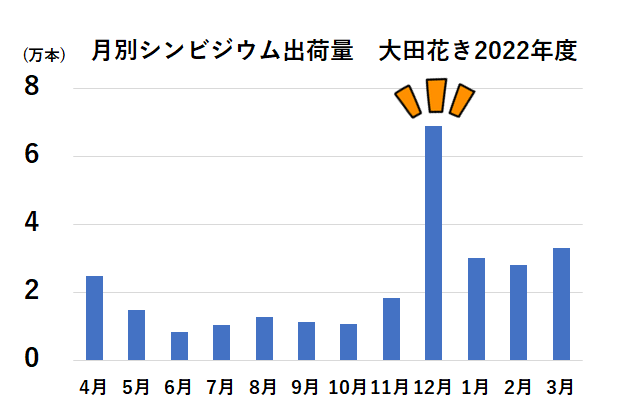
[Chart of Cymbidium production amount in Ota Floriculture in 2022. X-axis: month; Y-axis: ten thousand of Cymbidium]
Moreover, not only in spring but during this period when the supplement volume is at its maximum, Tokushima Prefecture is also the No.1 in domestic supplement share!
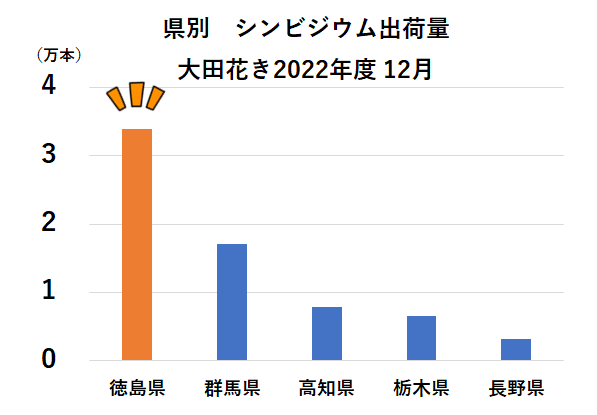
[Chart of Cymbidium production amount from various prefectures in Ota Floriculture in December 2022. X-axis: prefectures; Y-axis: ten thousand of Cymbidium]
[Prefectures: Tokushima/ Gunma/ Kouchi/ Tochigi/ Nagano]
According to Hirakawa, the sales representative at Ota Floriculture, “Among all Cymbidium traded at Ota Floriculture, products from Tokushima Prefecture have top-class quality, which has been established as a brand.” According to Kiuchi, the former sales representative at Ota Floriculture, “The quality is undoubtedly good the moment you see it. The vigour of the plant, the shine of the leaves, and the stretched-out flowers show the healthiness!”
This is not only about the quantity of supplement; there must be secrets to producing high-quality flowers.
So, in order to explore the secrets of the high-quality Cymbidium in Tokushima Prefecture, we interviewed two producers.
1st Stop: Ueno Ryokufu-en (Ueno Green Breeze Garden)
Approximately 50 minutes by car from Awa Odori Airport, located in the clean air of Kamiyama town, Myozai county, surrounded by mountains and the Akui River, is “Ueno Ryokufu-en.”

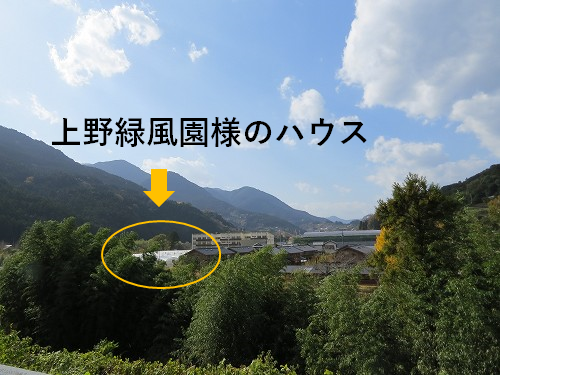
The Akui River flows near Mr. Ueno’s farm.

Mr. Masahiro Ueno, the representative director of Ueno Ryokufu-en, celebrated his 60th birthday this year.

■ Basic Information: Ueno Ryokufu-en
Products: Cymbidium (cut flowers)
Cultivated Area: Approximately 4,000 m2, about 20 greenhouses
Labor Force: Mr. Ueno, one employee, and one part-time employee, totaling three people
Mr. Ueno is the third generation of Ueno Ryokufu-en. Around 1958, Mr. Ueno’s grandfather began cultivating flowering plants such as Nandina Domestica, Chamaecyparis Pisifera ver. Filifera, and Juniperus Chinensis. The name “Ueno Ryokufu-en” gives the impression of a refreshing breeze passing through the trees.
They started producing Cymbidium in the time of Mr. Ueno’s father, around 1965. At that time, they also cultivated fruit trees such as Citrus Aurantium and grapes. Mr. Ueno, who took over in 1982, is now in his 38th year, specializing in Cymbidium production.
“I built these greenhouses myself. I leveled the terraced farm where flowering trees and fruit trees used to be.”
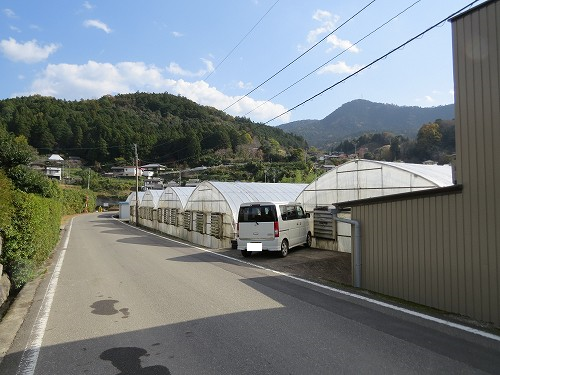

As a result, each size of the greenhouses is slightly different.
When we were shown inside the greenhouse, the depth was about 25m from the front to the back. Cymbidium pots were lined up neatly.

Seeing inside the pots, the roots were surprisingly thin and not thick.

Something like white fibers peeked out from between the roots.
What is this (・・)?
“It’s rock wool. We insert a tube into the pot for irrigation, and with rock wool, water spreads easily, and diseases are less likely to occur. It also requires fewer number of frequencies for repotting.”

Rock wool is artificially made fibre from minerals. It has high absorption of nutrients and water, and it excels in air permeability and water retention. It is used in vegetable cultivation such as tomatoes and peppers, as well as in flower cultivation for roses.
In this way, each pot has an irrigation tube inserted, and the frequency of watering is adjusted according to the temperature and atmospheric conditions.


Therefore, by growing in this medium, the absorption of water and nutrients is increased, resulting in thick roots and the nourishment of flowers.
■ Temperature Management is Crucial
The area Mr. Ueno is most concerned about in production is seedling cultivation. With the seedling grown in flasks, “Temperature management is crucial, with around 18°C being the ideal temperature. Excessive exposure to sunlight is not good, so moderate shading is necessary.”

It takes 4 to 5 years for Cymbidium to bloom from ordering the seedlings. During this time, they are carefully nurtured while managing the temperature, humidity, and water. For example, in Mr. Ueno’s farm, heating is applied during the day at 25°C and at night at 15°C in winter.




By circulating the heated air throughout the greenhouse, flowering is promoted.
However, temperature management poses a major challenge for Mr. Ueno. “Using heating like this for Cymbidium production leads to significant expenses in fuel costs. The fuel cost is about 3 to 4 times higher per liter than before, and electricity costs have also increased.”

Furthermore, what currently concerns Mr. Ueno the most is the shortage of labor. Managing 4,000 m2 with only three people is extremely challenging. 4,000 m2 is equivalent to approximately 25 volleyball courts. In other words, each person is responsible for managing an area larger than 8 volleyball courts.

Still, because of the highest demand of the year in December, Mr. Ueno and the other producers do their best to lift the plants to higher elevations in summer to encourage flowering. Lifting is a cultivation method where the cultivation site is moved to a higher and cooler place only during the hot period of summer. In Mr. Ueno’s case, they transport the pots to the mountains for three weeks using a 2-ton truck.
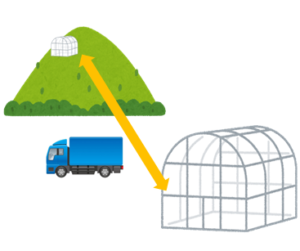
Once autumn comes, they bring down all the pots from the mountain, and in winter, they manage to bloom by applying heating.

The pipe-like structure attached to the ground inside the greenhouse is a lane for inserting carts. When lifting the pots up, it’s quite challenging to carry each of them outside the greenhouse, so the pots were loaded onto a trolley and transported out.
“It’s quite tough to continue the labor-intensive production with just three people.”

Fertilizing each pot one by one, inserting irrigation tubes, training the stems to grow straight, flower harvesting, sorting, packaging, and shipping – all these tasks are handled by just three individuals.
“Doing so much work with only three people is quite a challenge.” said Mr. Ueno.
■Creating because it’s Beautiful
Mr. Ueno’s synonymous variety is the “Snowflake”, a prize-winning variety, Flower of the Year OTA 2013 °˖✧◝(⁰▿⁰)◜✧˖°
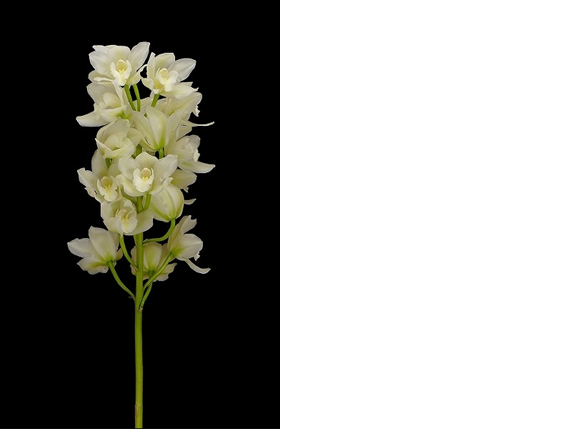
The magnificent flower arrangement with large, three-dimensional blooms and sturdy stems is truly impressive!
Why did you start cultivating Snowflakes?
“Because I found it beautiful.”
Thirty-three years ago, Mr. Ueno visited a well-known orchid farm in New Zealand with fellow enthusiasts. The owner of the farm decided to retire, so Mr. Ueno took over around 1,000 to 2,000 plants of about 10 different varieties. One of them is Snowflake.
However, Snowflake is quite delicate, and new flower buds are not easily formed.
According to the difficulties in cultivating Snowflakes, people barely produce this variety in Tokushima. Despite this, Mr. Ueno continues to cultivate them, precisely to meet the demand of customers who say, “We want them!”

When Mr. Ueno started production, he was deeply moved by the beautiful colors of orchids. All the varieties currently being produced reflect Mr. Ueno’s preferences. The flowers confidently crafted by Mr. Ueno are truly beautiful. They are praised for being “large and well-made,” especially by customers involved in bridal and funeral work. Mr. Ueno’s orchids, cultivated with care through proper nutrition, water absorption, and temperature management, are truly exceptional.
Variety: Snowflake

Variety: Culpaulin Ice
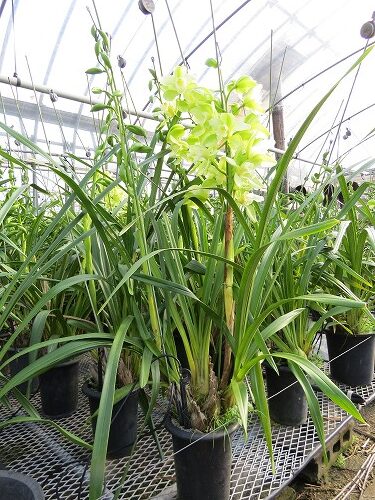

Variety: Wedding

Variety: Chelsea

Variety: Deep Impact
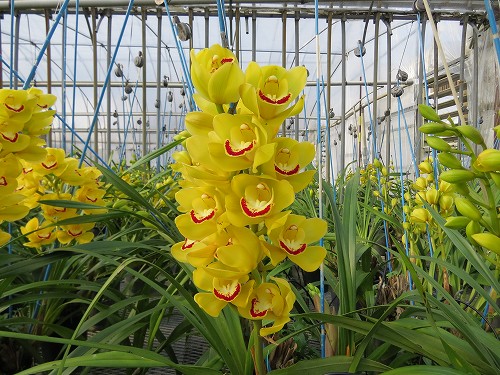
————————————————————————————————————————
Now, let’s move on to the second location, “Yasuda Orchid Garden,” about 50 minutes by car from Mr. Ueno’s Kamiyama town in Anan City, Nagakawa town.
Representative of Yasuda Orchid Garden, Mr. Hitoshi Yasuda, 59 years old.

Mr. Yasuda’s farm is about 2 meters above sea level, approximately 5 km from the coast.
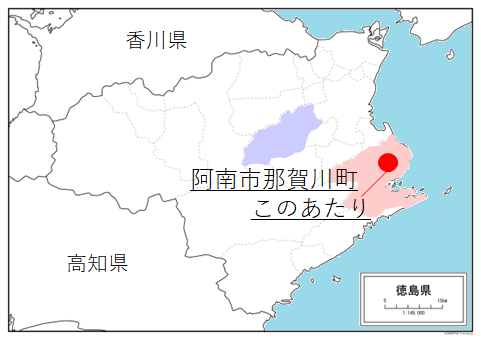
There are no buildings around the farm, and it’s an exposed location where the wind blows vigorously throughout the year, making it extremely dry no matter summer or winter.


However, on the other hand, the sunlight is abundant, and the amount of sunlight is exceptional.
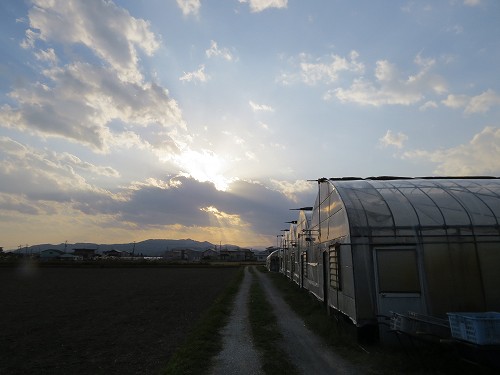
While visiting for an interview in spring, a fellow orchid producer’s farm was about 10 km from Mr. Uzushio Orchid Garden, but the cultivation environment was completely different.
■Basic Information: Yasuda Orchid Garden
Product: Cymbidium Orchids (cut flowers)
Production Area: Approximately 4,500 m2 (about 28 volleyball courts), and a greenhouse of roughly 1,500 m2 in the mountain for elevation.
Shipping Quantity: Approximately 60,000 stems (about 30,000 stems shipped out within the year)
Labor: 3 people including Mr. Yasuda, Mr. Yasuda’s wife, Mr. Yasuda’s sister, additionally around 4 part-time workers during the busy season.
Mr. Yasuda had been working in sales at a major company in Tokyo for many years.
“I enjoy taking on new challenges,” said Mr. Yasuda, “It is a good opportunity while not many people get the chance to start cultivation in an environment where their parents already have a greenhouse.” Making a fresh start at the age of 45, taking advantage of the well-equipped environment, he continued the production of Cymbidium orchids despite his parents’ objections.
When he started production, Mr. Yasuda and his wife visited many Cymbidiums orchid farms in the prefecture and received guidance on techniques and information from seniors who had been cultivating for two to three decades.
“The Awa Orchid Youth Club members generously taught us many things. They accepted someone with absolutely no experience at the age of 45 which is very kind.”

The “Awa Orchid Youth Club” is a group of producers who work across the boundaries of individual and group supplements to enhance the brand power of cymbidium orchids. They hold regular meetings once a month for information exchange, arrange cultivation technique lectures with invited speakers, and actively participate in exhibitions.
The producers in Tokushima Prefecture are warm and supportive companions. As previously introduced, Mr. Ueno is also a member of the Awa Orchid Youth Club and is actively involved in activities.
■Yasuda’s Approach is to Try
Mrs. Yasuda: “I thought we were cursed when we started production…”
C… cursed? What happened??

According to Mrs. Yasuda, the greenhouse consecutively collapsed from the first two years. To make matters worse, it was just before the crucial year-end supplements. The flowers were damaged, and almost none could be shipped out. The extent of the shock is immeasurable.
It was indeed a significant damage. However, the impact of the wind from this cyclone precisely illustrates the characteristics of Mr. Yasuda’s farm. Mr. Yasuda’s farm is near the sea, located in the middle of the plain. It receives excellent sunlight even during the winter solstice until nearly 4:30 PM. While this allows the flowers to undergo sufficient photosynthesis and grow large, there is nothing to block the wind, resulting in strong winds affecting the farm.

“We also experienced flooding. The water reached this part of the greenhouse. There were about 1-meter-long carp and catfish swimming inside the greenhouse.” said Mrs. Yasuda with a grin on her face.

However, Mr. Yasuda did not give up. “We not only rebuild the greenhouse but also build an additional one, making it from 4 to 5 greenhouses. Because of the damage, I was able to learn the structure of the greenhouse, electrical work, and plumbing in just one year.”
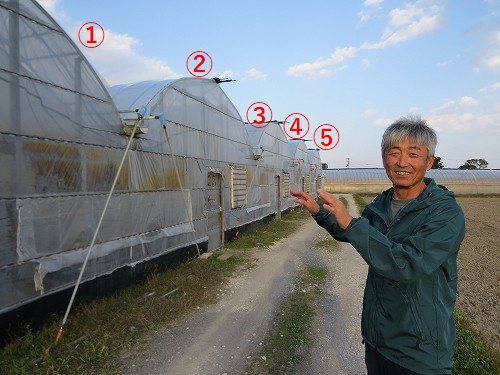
“During the flood, about a third of the pots had to be replaced. Therefore, we decided to update various varieties.”

Without a moment of despair, it was apparent that he possessed a considerable amount of mental strength to take on new challenges.
But how were the updated varieties selected?
“Through information exchange with the Youth Club and the market. For example, it seems that large white blooms sell well at the end of the year, but few people are still cultivating them. So, we took a shot at it. There are varieties that bloom within the year without needing to be moved uphill, so we gave them a try too. Of course, there are also many varieties that end up in storage.”

Based on information obtained through communication, Mr. Yasuda’s approach is to try things out first.
Here are some of the varieties he cultivates.
Variety Name: Winter Sonata
Mr. Yasuda’s flagship product. A large-blooming variety in high demand at the end of the year. During the interview, the buds still had a creamy hue.

After fully blooming for 2-3 days, it becomes completely white.
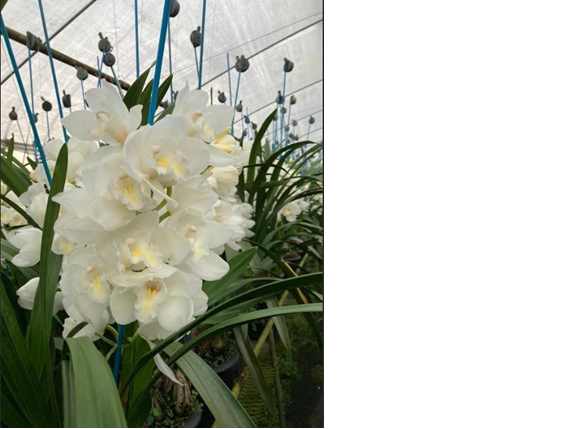
Variety Name: Autumn – a variety that blooms within the year without needing to be moved uphill.

Variety Name: Queen

Variety Name: Tart

Variety Name: Aiko Sama

Variety Name: Dancer

■ Moderate humidity, ample watering, and generous fertilization
When taking photos inside the greenhouse, the camera lens has fogged up.

“Our farm has higher humidity.”
Is it okay to have higher humidity?
“Don’t worry. It’s perfectly fine!”
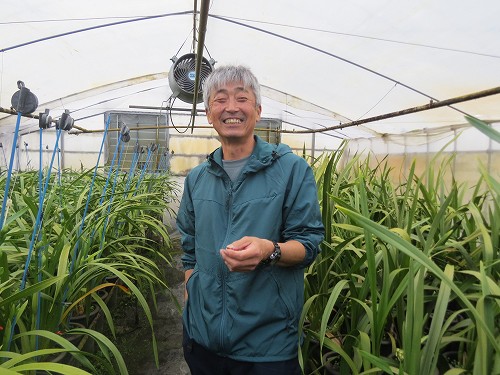
Now let’s recall the distinctive features of Mr. Yasuda’s farm. It’s situated in a location with excellent sunlight and where the wind blows vigorously. In other words, unlike the farms of other producers, it is in an extremely prone-to-drying environment. To protect the flowers from drying out, it’s crucial not only to water them but also to properly humidify the greenhouse.
“So, there’s a waterway inside the greenhouse.”
A waterway? Where exactly?
“It’s right underneath here.”

Oh, indeed! When crouching and looking under the shelf of pots, there’s a stream of water flowing through.
“There are also crayfish in it.” they said.

The novating appearance of an internal waterway and fish might be the first time in the long history of exploring Mr. Yasuda’s greenhouse! Is it something related to biotope?
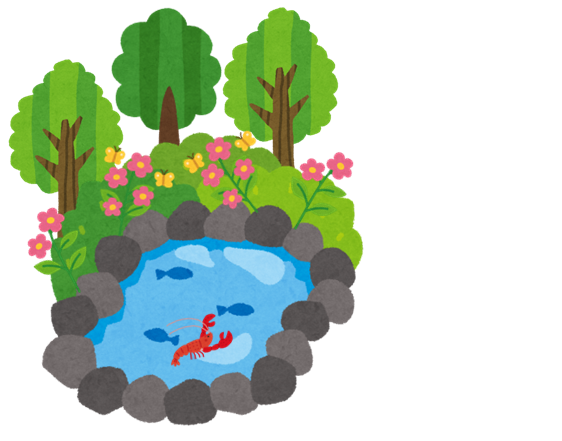
When heating the greenhouse, the water in the waterway evaporates. The plants prevent dryness by absorbing water in the warm air filled with water vapor. It’s similar to providing moisture to dry skin in winter with mist.
How Mr. Yasuda fertilizes is also unique.
“When I want the flowers to grow larger, I fertilize more. While doing it just before they bloom, the flowers will grow bigger. Due to the abundant sunlight, balance is held by providing a bit more water, fertilizer, and humidity. That’s our characteristic.”
The timing of fertilizer application, amount of water, and humidity regulation vary from producer to producer. Mr. Yasuda manages them appropriately to suit the greenhouse environment.
■ Desire of Creating Large Flowers
Looking at the bulbs of the Cymbidium (a part of the stem at the base of the plant that is round, large, and swollen, serving to store water and nutrients), some have turned into brown or grayish color.
“This is the bulb that bloomed last year. After the flower finishes blooming, the leaves will be cut. If we keep them, they will wither because they can no longer perform photosynthesis.”
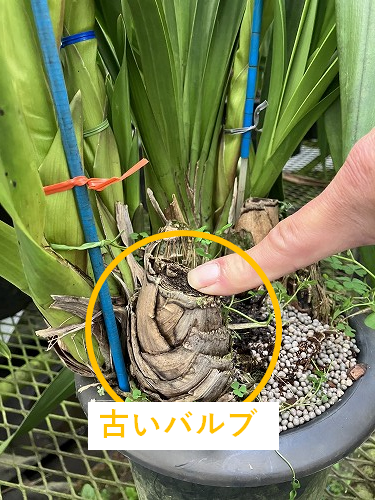
Cymbidium plants can last for more than a decade, with new flower buds and leaf buds emerging every year. Usually, old bulbs are said to send nutrients to the new bulbs, so we leave them until the new bulbs grow sufficiently. However, Mr. Yasuda intentionally cuts the leaves of the old bulbs while the new bulbs are still growing.
Why does the leaf cutting begin so early? Wouldn’t cutting them so soon prevent photosynthesis and hinder the supply of nutrients to the new bulbs?
“Cutting the leaves of the old bulbs early is to ensure that the leaves of the new bulbs receive sufficient light for photosynthesis. If the old leaves were left, isn’t it possible that the light would be blocked and affects the new leaves? Besides, it’s challenging to care for and maintain when there are many leaves.”

“As long as the bulb is alive, the roots are alive too. If there are old roots, there won’t be space for the new bulb’s roots to grow. By withering the old ones, there will be spaces to allow the new roots to extend.”

Furthermore, “By cutting the leaves, we created space around the pots, and we could increase the number of pots.”
By cutting the leaves of the old bulbs early, there are many benefits to this approach as following:
– Photosynthesis concentrates on the leaves of the new bulbs, which makes flower buds and leaf buds grow well.
– The roots of the new bulbs spread well to absorb water and nutrients.
– With fewer leaves, tasks like stem attraction become easier.
– The number of pots that can be placed on the farm increases.

Certainly, stems that have undergone plenty of photosynthesis and absorbed nutrients are sturdy.
But what if cutting the old leaves early doesn’t result in new flowers… Wouldn’t there be concerns?
“To be honest, I didn’t think too much… what I thought was just do it if I have any doubts on something. That’s my approach.”
If in doubt, try it. That’s Mr. Yasuda’s style.
The method of early leaf cutting is not found in any book. In the beginning, other producers found it difficult to accept an approach they had never seen before. However, seeing Mr. Yasuda successfulness, more producers started to believe the method and gradually adopting it.
By thoroughly carrying out photosynthesis for each stem, providing sufficient fertilizer and water, and properly humidifying, they create magnificent large flowers concentrated with nutrients.
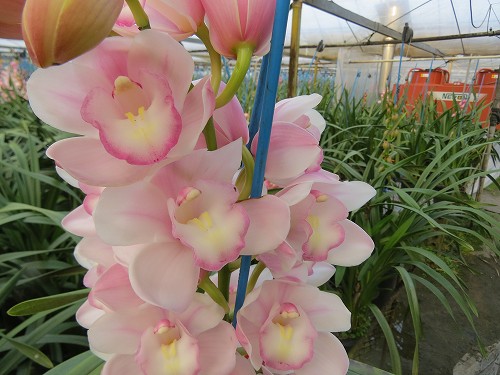
“When I first visited a colleague’s greenhouse at the beginning of my production, I was captivated by the luxurious Cymbidium with large flowers.”
■ Dyed Cymbidium Orchids
There is a recent focus within the Awa Orchid Youth Club, where Mr. Yasuda and Mr. Ueno belong, on a particular initiative by enthusiasts known as the “Dye Dye Club.” The initiative involves something quite literal – “Dyed Cymbidium Orchids.”

The blues and light aquas are especially beautiful. The colourful images here capture an exhibition held at an event organized by a company in Tokushima Prefecture in 2023’s spring.
Cymbidium orchids typically take about 4-5 years from ordering the seedlings to blooming. Predicting demand 4-5 years ahead is challenging, and colors that are popular for short periods during events like Halloween or Christmas pose a challenge for producers. Hence, the “Dye Dye Club” was launched to actively engage in dyeing, allowing for the expression of colours that align with trends and events.
Here is the “Dyed Deep Rouge,” a variety of Cymbidium dyed in red.


The “Dyed Deep Orange,” featuring the Autumn variety.


By using the red-pink Autumn variety, they successfully capture the trendy muted nuance colors.
To avoid confusion for customers who might not know the names when placing orders, the catalogue arrangement with unified names for the dyed Cymbidium orchids is in consideration.
Mr. Yasuda, speaking with a grin, says, “Since varieties take dye differently in-between, there’s still a lot we haven’t tried. I’ve learned a lot from my colleagues, so I want to be able to discuss techniques and management on an equal footing. I want to provide my feedback for return of favor.”

[Philosophies of Mr. Ueno Ryokufu-en and Mr. Yasuda Yoran-en]
– Never forget one’s initial intentions. People should pursue the target(flower) they aim for.
Maintaining the excitement and feelings when they first saw Cymbidium orchids, they put effort into each pot, producing Cymbidium orchids that are close to the ideal forms.
– Value exchanges and interactions with fellow enthusiasts.
Through information exchange with colleagues and the market, people enhance cultivation techniques. It is the passionate desire people felt to go beyond individual and group boundaries and contribute to the flourishing production of Cymbidium orchids in Tokushima Prefecture.
– Just do it!
Cymbidium orchids bloom only once a year. Therefore, if in doubt, it’s best to take on challenges without hesitation. “Failure is the mother of success (high quality).”
It’s evident that Mr. Ueno and Mr. Yasuda are well acquainted with each other’s farms and regularly exchange ideas. The exchange of information among colleagues seems to be a strength for the quality and production volume of Tokushima Prefecture’s Cymbidium orchids. Please consider using Tokushima Prefecture’s Cymbidium orchids for Christmas and New Year celebrations.
Production: Ota Floriculture Research Institute Ltd.
Translation: Ms. Shang Kuan; Edit: Mr. Kato
————————————————————————————————————————
Responsibility for the text and photos: Kuramitsurika@Ota Flower Life Research Institute
*Photos from the dyed orchid exhibition were provided by Mr. Yasuda Yoran-en.
